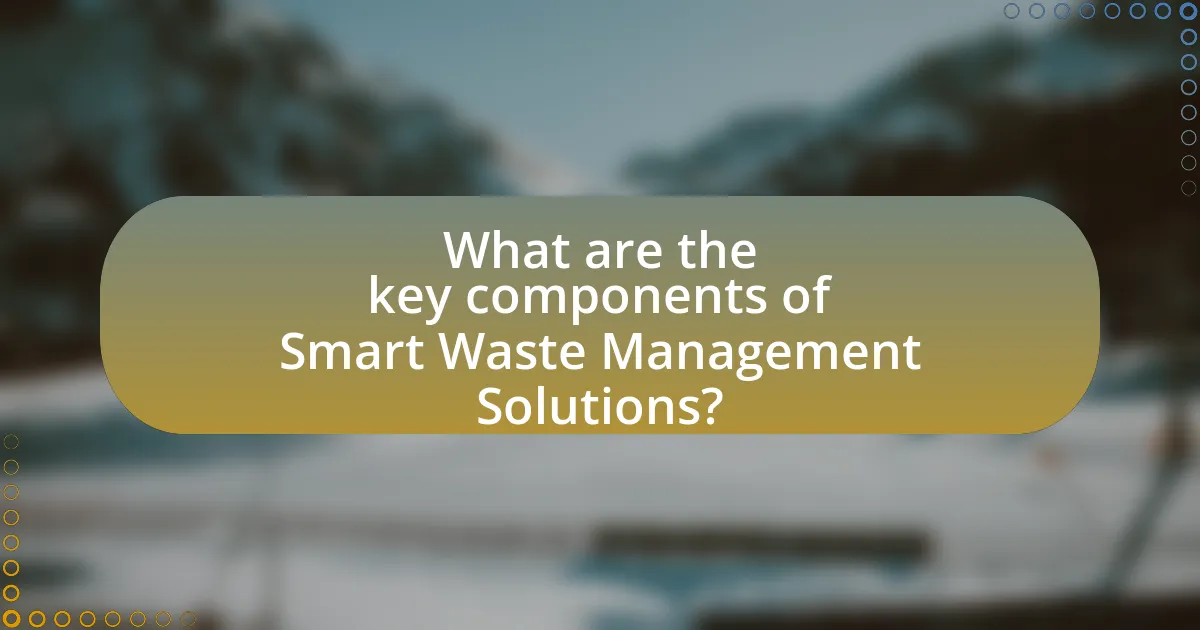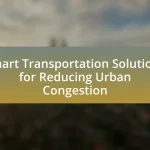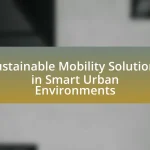Smart waste management solutions in urban areas are advanced systems that leverage technology to enhance the efficiency of waste collection, processing, and disposal. These solutions incorporate IoT sensors, data analytics, and mobile applications to monitor waste levels in real-time, optimize collection routes, and engage communities in recycling efforts. The article explores how these technologies function, their environmental benefits, the challenges urban areas face in waste management, and best practices for implementation. Additionally, it highlights the significant cost savings and operational efficiencies achieved through smart waste management initiatives, as well as the importance of community involvement in promoting sustainable practices.

What are Smart Waste Management Solutions in Urban Areas?
Smart waste management solutions in urban areas are innovative systems that utilize technology to optimize waste collection, processing, and disposal. These solutions often include smart bins equipped with sensors that monitor fill levels, enabling efficient collection routes and schedules. For instance, cities like Barcelona have implemented smart waste management systems that have reduced collection costs by up to 30% and improved recycling rates by providing real-time data on waste levels. Additionally, the integration of mobile applications allows residents to report issues and access information about waste services, further enhancing community engagement and efficiency.
How do Smart Waste Management Solutions function?
Smart Waste Management Solutions function by utilizing technology to optimize waste collection and disposal processes. These solutions typically involve the use of sensors in waste bins that monitor fill levels, enabling real-time data collection. This data is transmitted to a centralized system, which analyzes the information to determine the most efficient collection routes and schedules. For instance, a study by the International Solid Waste Association found that implementing smart waste management can reduce collection costs by up to 30% and improve recycling rates by providing timely data on waste generation patterns.
What technologies are integrated into Smart Waste Management Solutions?
Smart Waste Management Solutions integrate technologies such as IoT sensors, data analytics, GPS tracking, and mobile applications. IoT sensors monitor waste levels in real-time, enabling efficient collection schedules and reducing operational costs. Data analytics processes the collected data to optimize routes and predict waste generation patterns. GPS tracking enhances the monitoring of waste collection vehicles, ensuring timely pickups. Mobile applications facilitate communication between waste management authorities and citizens, promoting community engagement and reporting of issues. These technologies collectively improve the efficiency and effectiveness of waste management in urban areas.
How do these technologies improve waste collection efficiency?
Smart waste management technologies improve waste collection efficiency by utilizing data analytics, IoT sensors, and route optimization algorithms. These technologies enable real-time monitoring of waste levels in bins, allowing collection services to prioritize pickups based on actual need rather than fixed schedules. For instance, cities implementing smart bins equipped with sensors have reported up to a 30% reduction in collection costs and a significant decrease in fuel consumption due to optimized routing. Additionally, data analytics helps in predicting waste generation patterns, further enhancing operational efficiency and resource allocation.
What challenges do urban areas face in waste management?
Urban areas face significant challenges in waste management, including high population density, inadequate infrastructure, and limited funding. High population density leads to increased waste generation, making it difficult to manage and dispose of waste effectively. Inadequate infrastructure, such as insufficient collection services and recycling facilities, exacerbates the problem, resulting in overflowing landfills and environmental pollution. Limited funding restricts the ability of municipalities to implement advanced waste management technologies and programs, further complicating efforts to achieve sustainable waste management. According to the World Bank, urban areas generate approximately 1.3 billion tons of solid waste annually, a figure expected to increase by 70% by 2050 if no action is taken.
How does population density impact waste generation?
Population density significantly impacts waste generation, as higher densities typically lead to increased waste production per unit area. Urban areas with dense populations, such as cities, generate more waste due to concentrated living conditions, commercial activities, and limited space for waste disposal. For instance, a study by the United Nations estimates that urban areas, which house over half of the global population, contribute approximately 70% of total waste generated. This correlation indicates that as population density rises, the volume of waste generated also increases, necessitating more efficient waste management solutions to handle the higher waste output effectively.
What are the environmental implications of poor waste management?
Poor waste management leads to significant environmental implications, including soil contamination, water pollution, and increased greenhouse gas emissions. When waste is improperly disposed of, hazardous materials can leach into the soil, affecting local ecosystems and potentially entering the food chain. For instance, a study by the World Bank indicates that improper waste disposal contributes to the contamination of groundwater sources, posing health risks to communities. Additionally, landfills produce methane, a potent greenhouse gas, which exacerbates climate change. According to the Environmental Protection Agency, landfills are the third-largest source of methane emissions in the United States. Furthermore, poor waste management can lead to increased litter in urban areas, harming wildlife and degrading natural habitats.

What are the benefits of implementing Smart Waste Management Solutions?
Implementing Smart Waste Management Solutions significantly enhances efficiency in waste collection and disposal. These solutions utilize technology such as IoT sensors and data analytics to optimize routes for waste collection vehicles, reducing fuel consumption and operational costs by up to 30%. Additionally, they improve recycling rates by providing real-time data on waste levels, allowing for timely pickups and better resource allocation. Studies indicate that cities employing smart waste management can reduce landfill waste by 20% or more, contributing to environmental sustainability.
How do these solutions enhance operational efficiency?
Smart waste management solutions enhance operational efficiency by optimizing waste collection routes and schedules, thereby reducing fuel consumption and labor costs. For instance, the implementation of IoT sensors in waste bins allows for real-time monitoring of fill levels, enabling waste management companies to dispatch collection vehicles only when necessary. This targeted approach can lead to a reduction in collection frequency by up to 30%, as evidenced by case studies from cities like Barcelona, which reported significant savings in operational costs and improved service delivery. Additionally, data analytics can identify patterns in waste generation, allowing for better resource allocation and planning, further streamlining operations.
What role does data analytics play in optimizing waste collection routes?
Data analytics plays a crucial role in optimizing waste collection routes by enabling data-driven decision-making that enhances efficiency and reduces operational costs. By analyzing historical waste generation data, traffic patterns, and collection schedules, waste management companies can identify the most efficient routes for collection vehicles. For instance, a study by the Environmental Protection Agency found that optimizing routes can reduce fuel consumption by up to 30%, leading to significant cost savings and lower emissions. Additionally, real-time data analytics allows for dynamic route adjustments based on current conditions, such as traffic or unexpected waste volume changes, further improving the effectiveness of waste collection operations.
How can real-time monitoring reduce operational costs?
Real-time monitoring can reduce operational costs by optimizing resource allocation and minimizing waste collection inefficiencies. By utilizing sensors and data analytics, waste management systems can track fill levels in bins, allowing for targeted collection routes and schedules. This approach decreases fuel consumption and labor costs, as evidenced by a study from the University of California, which found that smart waste management systems can reduce collection costs by up to 30% through improved route efficiency and reduced frequency of pickups.
What environmental benefits do Smart Waste Management Solutions provide?
Smart Waste Management Solutions provide significant environmental benefits by optimizing waste collection and reducing landfill usage. These solutions utilize technology such as sensors and data analytics to monitor waste levels in real-time, leading to more efficient collection routes and schedules. This efficiency decreases greenhouse gas emissions from collection vehicles, as evidenced by a study from the University of California, which found that optimized routes can reduce emissions by up to 30%. Additionally, Smart Waste Management promotes recycling and composting by providing users with information on proper waste disposal, thereby diverting waste from landfills and conserving natural resources.
How do these solutions contribute to reducing landfill waste?
Smart waste management solutions contribute to reducing landfill waste by optimizing waste collection and promoting recycling. These solutions utilize technology, such as sensors and data analytics, to monitor waste levels in real-time, allowing for more efficient collection routes and schedules. For instance, cities implementing smart bins equipped with sensors can reduce unnecessary pickups, leading to lower operational costs and decreased emissions. Additionally, these solutions often include educational components that encourage residents to recycle and compost, further diverting waste from landfills. According to a study by the Environmental Protection Agency, effective recycling programs can reduce landfill waste by up to 30%, demonstrating the significant impact of smart waste management initiatives.
What impact do they have on urban pollution levels?
Smart waste management solutions significantly reduce urban pollution levels by optimizing waste collection and disposal processes. These solutions, such as smart bins equipped with sensors, enable real-time monitoring of waste levels, leading to more efficient collection routes and reduced vehicle emissions. For instance, a study by the World Bank found that implementing smart waste management systems can decrease greenhouse gas emissions by up to 30% in urban areas. Additionally, these systems promote recycling and proper waste segregation, further minimizing landfill overflow and associated pollution.

What are the key components of Smart Waste Management Solutions?
The key components of Smart Waste Management Solutions include IoT sensors, data analytics, waste collection optimization, and user engagement platforms. IoT sensors are deployed in waste bins to monitor fill levels in real-time, enabling efficient collection schedules. Data analytics processes the information gathered from these sensors to identify patterns and optimize routes for waste collection vehicles, reducing operational costs and environmental impact. Waste collection optimization ensures that resources are allocated effectively, minimizing unnecessary trips. User engagement platforms, such as mobile apps, facilitate communication between residents and waste management authorities, promoting recycling and proper waste disposal practices. These components collectively enhance the efficiency and sustainability of waste management in urban areas.
What types of technologies are commonly used?
Smart waste management solutions in urban areas commonly utilize technologies such as IoT sensors, data analytics, and automated collection systems. IoT sensors are deployed in waste bins to monitor fill levels in real-time, enabling optimized collection routes and schedules. Data analytics processes the information gathered from these sensors to identify patterns in waste generation, which helps in resource allocation and planning. Automated collection systems, including robotic waste collectors, enhance efficiency and reduce labor costs. These technologies collectively improve operational efficiency and sustainability in urban waste management.
How do smart bins work in waste management?
Smart bins in waste management utilize sensors and IoT technology to monitor waste levels and optimize collection routes. These bins are equipped with fill-level sensors that detect when they are nearing capacity, allowing waste management services to schedule pickups more efficiently. For instance, a study by the University of Cambridge found that smart bins can reduce collection costs by up to 30% by minimizing unnecessary trips. Additionally, data collected from these bins can be analyzed to improve overall waste management strategies and promote recycling efforts.
What is the role of IoT in waste management systems?
The role of IoT in waste management systems is to enhance efficiency and effectiveness through real-time data collection and analysis. IoT devices, such as smart bins equipped with sensors, monitor waste levels and optimize collection routes, reducing operational costs and environmental impact. For instance, a study by the World Economic Forum highlighted that cities implementing IoT solutions in waste management can reduce collection costs by up to 30% and improve recycling rates by providing timely data to waste management authorities. This integration of IoT technology leads to smarter, more sustainable urban waste management practices.
What data is collected and how is it utilized?
Smart waste management solutions in urban areas collect data on waste generation, collection routes, bin fill levels, and recycling rates. This data is utilized to optimize collection schedules, reduce operational costs, and improve recycling efforts. For instance, sensors in waste bins provide real-time fill level data, allowing waste management services to deploy collection vehicles only when necessary, thereby minimizing fuel consumption and labor costs. Additionally, analyzing waste generation patterns helps municipalities implement targeted recycling programs, enhancing overall waste diversion rates.
How does data collection improve waste sorting and recycling processes?
Data collection enhances waste sorting and recycling processes by providing actionable insights into waste composition and disposal patterns. By analyzing data from sensors and smart bins, municipalities can identify the types and quantities of materials being discarded, allowing for targeted educational campaigns and optimized collection routes. For instance, a study by the Ellen MacArthur Foundation found that cities utilizing data analytics improved recycling rates by up to 20% through better resource allocation and public awareness initiatives. This data-driven approach not only increases efficiency but also fosters community engagement in recycling efforts.
What insights can be gained from waste generation patterns?
Waste generation patterns provide insights into consumption behaviors, resource allocation, and environmental impact. By analyzing these patterns, municipalities can identify peak waste generation times, types of waste produced, and the effectiveness of recycling programs. For instance, a study by the Environmental Protection Agency indicates that urban areas generate approximately 4.5 pounds of waste per person per day, highlighting the need for targeted waste reduction strategies. Understanding these patterns enables cities to implement smart waste management solutions, optimize collection routes, and enhance recycling efforts, ultimately leading to more sustainable urban environments.
How can cities effectively implement Smart Waste Management Solutions?
Cities can effectively implement Smart Waste Management Solutions by integrating IoT technology, data analytics, and community engagement. The use of IoT sensors in waste bins allows for real-time monitoring of waste levels, optimizing collection routes and schedules based on actual need rather than fixed schedules. For instance, cities like Barcelona have successfully deployed smart bins that notify waste management services when they are full, reducing unnecessary pickups and lowering operational costs.
Data analytics plays a crucial role in understanding waste generation patterns, enabling cities to tailor their waste management strategies. A study by the World Bank indicates that cities employing data-driven approaches can reduce waste collection costs by up to 30%. Furthermore, engaging the community through awareness campaigns and mobile applications encourages responsible waste disposal and recycling practices, leading to increased participation in waste management initiatives.
By combining these technologies and strategies, cities can enhance efficiency, reduce costs, and promote sustainability in waste management.
What are the best practices for integrating technology into existing systems?
The best practices for integrating technology into existing systems include conducting a thorough assessment of current infrastructure, ensuring compatibility with existing technologies, and prioritizing user training and support. A comprehensive assessment identifies gaps and opportunities for improvement, while compatibility ensures that new technologies can seamlessly interact with legacy systems. User training and support are crucial for maximizing the effectiveness of the integration, as studies show that organizations with robust training programs experience a 30% increase in technology adoption rates. Additionally, implementing a phased approach allows for gradual integration, minimizing disruption and allowing for adjustments based on feedback.
How can community engagement enhance the success of these solutions?
Community engagement enhances the success of smart waste management solutions in urban areas by fostering collaboration between residents and local authorities. Engaged communities are more likely to participate in recycling programs, adhere to waste segregation practices, and provide valuable feedback on waste management initiatives. For instance, a study by the Environmental Protection Agency found that cities with active community involvement in waste management saw a 20% increase in recycling rates compared to those without such engagement. This active participation not only improves compliance but also leads to tailored solutions that address specific local needs, ultimately resulting in more effective waste management outcomes.
What are some common challenges in adopting Smart Waste Management Solutions?
Common challenges in adopting Smart Waste Management Solutions include high initial costs, lack of infrastructure, data privacy concerns, and resistance to change from stakeholders. High initial costs can deter municipalities from investing in advanced technologies, as they may require significant upfront capital for implementation. Additionally, many urban areas lack the necessary infrastructure, such as reliable internet connectivity and sensor-equipped bins, which are essential for effective smart waste management. Data privacy concerns arise when collecting and analyzing data from waste management systems, leading to apprehension among citizens regarding how their information is used. Lastly, resistance to change from stakeholders, including waste management workers and local governments, can hinder the adoption of innovative solutions, as they may be accustomed to traditional methods and skeptical of new technologies.
How can cities overcome resistance to technological change?
Cities can overcome resistance to technological change by actively engaging stakeholders through education and transparent communication. By informing residents and businesses about the benefits of smart waste management solutions, such as increased efficiency and cost savings, cities can foster a positive perception of technology. For instance, a study by the World Economic Forum highlights that cities implementing community outreach programs saw a 30% increase in public support for new technologies. Additionally, involving community members in the decision-making process can enhance trust and reduce apprehension, as evidenced by successful pilot programs in cities like San Francisco, where public input led to higher adoption rates of smart waste bins.
What funding options are available for implementing these solutions?
Various funding options are available for implementing smart waste management solutions in urban areas, including government grants, public-private partnerships, and environmental impact bonds. Government grants, such as those from the Environmental Protection Agency, provide financial support specifically for innovative waste management projects. Public-private partnerships allow municipalities to collaborate with private companies, sharing costs and resources for the development and implementation of smart technologies. Environmental impact bonds enable cities to finance projects based on the anticipated savings from improved waste management, thus attracting private investment. These funding avenues are essential for advancing smart waste management initiatives and enhancing urban sustainability.
What practical tips can cities follow to optimize Smart Waste Management Solutions?
Cities can optimize Smart Waste Management Solutions by implementing real-time monitoring systems for waste levels in bins, which allows for efficient collection routes and schedules. Utilizing IoT sensors in waste containers can provide data on fill levels, enabling waste management services to reduce unnecessary pickups and save fuel costs. Additionally, cities should promote public awareness campaigns to encourage recycling and proper waste disposal, which can lead to a significant reduction in landfill waste. According to a study by the World Bank, effective waste management practices can reduce urban waste by up to 30%, demonstrating the impact of these strategies. Furthermore, integrating data analytics can help cities identify trends and optimize resource allocation, enhancing overall waste management efficiency.


